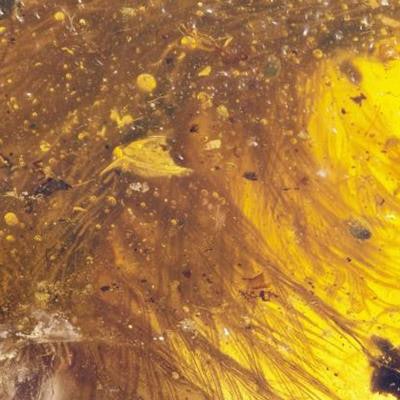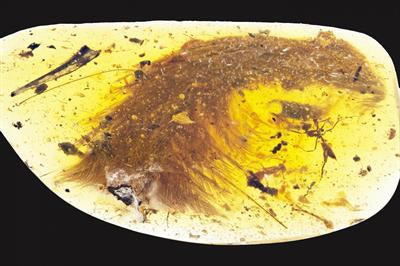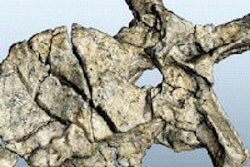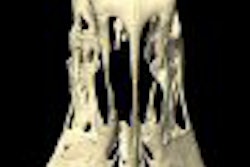
CT imaging has revealed what Chinese investigators are calling the first intact tail vertebrae from a feathered dinosaur that distinguishes it from a prehistoric bird, according to a new study in Current Biology.
The researchers, led by paleontologist Lida Xing from the China University of Geosciences, analyzed the vertebrae of what they believe is a young coelurosaur, part of a group of theropod dinosaurs that includes everything from Tyrannosaurus rex to modern birds (Curr Biol, December 8, 2016).
The 99-million-year-old sample was found in a piece of amber that had already been shaped and polished for sale. The sample, nicknamed "Eva" in honor of paleobotanist Eva Koppelhus, came from a mine in the Hukawng Valley in northern Myanmar. Amber from this region contains a variety of animal and plant life from the Cretaceous period.
 Photograph shows the tip of a preserved dinosaur tail section, showing carbon film at its surface exposure and feathers arranged in keels down both sides of the tail. Image courtesy of Royal Saskatchewan Museum (RSM/R.C. McKellar).
Photograph shows the tip of a preserved dinosaur tail section, showing carbon film at its surface exposure and feathers arranged in keels down both sides of the tail. Image courtesy of Royal Saskatchewan Museum (RSM/R.C. McKellar).Both CT and microscope images showed eight vertebrae from the middle or end of a long, thin tail that may have originally contained as many as 25 vertebrae covered in feathers. The group concluded that if the entire length of the dinosaur tail was covered in the feathers seen in the sample, the dinosaur would have been incapable of flight, with the feathers serving instead for signaling, temperature regulation, or other purposes.
The specimen also offers insight into feather evolution, according to a release from Cell Press, the publisher of Current Biology. The feathers lack a well-developed central shaft or rachis, and the structure suggests that the two finest tiers of branching in modern feathers, barbs and barbules, arose before a rachis formed.
The early stage of development suggests that the animal was evolutionarily a more primitive theropod dinosaur such as a primitive maniraptoran, according to the researchers. The presence of articulated tail vertebrae enabled the team to exclude the possibility that the feathers belonged to a prehistoric bird, which, along with their modern counterparts, have fused tail vertebrae called pygostyles that enable the tail to move as a single unit.
The amber also contained ferrous iron, due to decomposition of blood hemoglobin in the dinosaur's soft tissue. The presence of iron gives the research team hope that future analysis might lead to more chemical information from this and future samples.




















